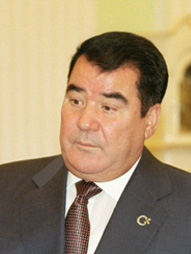
Back صفرمراد نيازوف Arabic صفرمراد نيازوف ARZ Saparmyrat Nyýazow AST Saparmurat Niyazov Azerbaijani Ниязов Сапарморат Атай улы Bashkir Saparmurat Niyazov BCL Сапармурат Ніязаў Byelorussian Сапармурат Ніязаў BE-X-OLD Сапармурад Ниязов Bulgarian সাপারমুরাত নিয়াজভ Bengali/Bangla
Saparmurat Niyazov | |
|---|---|
Saparmyrat Nyýazow | |
 Niyazov in 2002 | |
| 1st President of Turkmenistan | |
| In office 2 November 1990 – 21 December 2006 | |
| Prime Minister | Han Ahmedow (1990–92) |
| Vice President | |
| Preceded by | Office established |
| Succeeded by | Gurbanguly Berdimuhamedow |
| Leader of the Democratic Party of Turkmenistan | |
| In office 27 October 1991 – 21 December 2006 | |
| Preceded by | Office established |
| Succeeded by | Gurbanguly Berdimuhamedow |
| First Secretary of the Central Committee of the Communist Party of Turkmenistan | |
| In office 21 December 1985 – 16 December 1991 | |
| Preceded by | Muhammetnazar Gapurow |
| Succeeded by | Office abolished |
| Full member of the 28th Politburo | |
| In office 14 July 1990 – 29 August 1991 | |
| Personal details | |
| Born | Saparmyrat Ataýewiç Nyýazow 19 February 1940 Gypjak, Turkmen SSR, Soviet Union |
| Died | 21 December 2006 (aged 66) Ashgabat, Turkmenistan |
| Political party | Democratic Party of Turkmenistan (1991–2006) |
| Other political affiliations | Communist Party of Turkmenistan (1962–1991) Communist Party of the Soviet Union (1962–1991) |
| Spouse | [1] |
| Children | 2 |
| Parents |
|
| Education | Leningrad Polytechnic Institute |
| Profession | Electrical engineer |
| Nickname | Türkmenbaşy |
| Military service | |
| Allegiance | |
| Branch/service | |
| Rank | General of the Army[2] |
| ||
|---|---|---|
|
President of Turkmenistan 1990-2006
Government
election Others Family  |
||
Saparmurat Atayevich Niyazov (Russian: Сапармурат Атаевич Ниязов; Turkmen: Saparmyrat Ataýewiç Nyýazow;[a] 19 February 1940 – 21 December 2006), also known as Türkmenbaşy,[b] was a Turkmen dictator who ruled Turkmenistan from 1985 until his death in 2006. He was first secretary of the Turkmen Communist Party from 1985 until 1991 and supported the 1991 Soviet coup attempt. He continued to rule Turkmenistan for 15 years after independence from the Soviet Union in 1991.
Turkmen media referred to him using the title, His Excellency Saparmurat Türkmenbaşy, President of Turkmenistan and Chairman of the Cabinet of Ministers.[3] His self-given title Türkmenbaşy, meaning Head of the Turkmen, referred to his position as the founder and president of the Association of Turkmens of the World.[4] In 1999, the Assembly of Turkmenistan declared Niyazov President for life of Turkmenistan.
In his time, he was one of the world's most totalitarian, despotic, and repressive dictators.[5][6] He promoted a cult of personality around himself and imposed his personal eccentricities upon the country, such as renaming Turkmen months and days of the week to references of his autobiography the Ruhnama.[7] He made it mandatory to read the Ruhnama in schools, universities and governmental organizations; new governmental employees were tested on the book at job interviews and an exam on its teachings was a part of the driving test in Turkmenistan. In 2005, he closed down all rural libraries and hospitals outside of the capital city Ashgabat, in a country where at that time more than half the population lived in rural areas,[8] once stating that, "If people are ill, they can come to Ashgabat."[9]
Under his rule, Turkmenistan had the lowest life expectancy in Central Asia. Global Witness, a London-based human rights organisation, reported that money under Niyazov's control and held overseas may be in excess of US$3 billion, of which between $1.8–$2.6 billion was allegedly situated in the Foreign Exchange Reserve Fund at Deutsche Bank in Germany.[10]
- ^ Наследником Туркменбаши может стать следователь московской прокуратуры. Kp.ru - (in Russian). Komsomolskaya Pravda. 22 December 2006. Archived from the original on 27 June 2023. Retrieved 22 December 2006.
- ^ Öçmejek şöhrat – Türkmen Edebiyaty – Publisistika. (9 May 2020). In kitapcy.com. http://kitapcy.com/news/ocmejek_sohrat/2020-05-09-61[permanent dead link] There is a police academy named after Niyazov called "General of the Army Saparmyrat Nyýazow Academy", meaning he had been promoted at some point during his presidency.
- ^ Warren, Marcus (9 August 2002). "A date with destiny for Turkmen leader". The Daily Telegraph. Moscow. Archived from the original on 15 December 2018. Retrieved 14 December 2018.
- ^ "Turkmenistan Fact Sheet, Government & Politics – President". Embassy of Turkmenistan. Archived from the original on 13 August 2002. Retrieved 22 December 2006.
- ^ Theroux, Paul (21 May 2007). "The Golden Man". The New Yorker. Archived from the original on 19 January 2021. Retrieved 22 January 2021.
- ^ Cathill, Paul (26 September 2018). "Interesting Histories: Saparmurat Niyazov – The Real General Aladeen". medium.com. Archived from the original on 28 January 2021. Retrieved 22 January 2021.
- ^ "Turkmen go back to old calendar". BBC News. 24 April 2008. Archived from the original on 19 April 2020. Retrieved 24 April 2008.
- ^ "Rural population (% of total population): Turkmenistan". World Bank. Archived from the original on 17 June 2019. Retrieved 16 December 2018.
- ^ BBC News, "Turkmen leader closes hospitals", 1 March 2005 Archived 19 December 2020 at the Wayback Machine.
- ^ "It's a Gas: Funny Business in the Turkmen-Ukraine Gas Trade" (PDF). Global Witness Limited. April 2006. Archived (PDF) from the original on 1 November 2018. Retrieved 9 December 2010.
Cite error: There are <ref group=lower-alpha> tags or {{efn}} templates on this page, but the references will not show without a {{reflist|group=lower-alpha}} template or {{notelist}} template (see the help page).
© MMXXIII Rich X Search. We shall prevail. All rights reserved. Rich X Search



